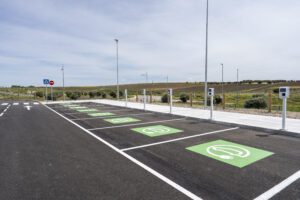Decarbonising the logistics industry is a major challenge and a group of GLP colleagues and customers sat down at the recent GLP Global Customer Conference to discuss the main obstacles as well as the potential solutions and pathways for reducing carbon and meeting climate targets.
Among the main issues discussed were limitations with the capacity of the grid for solar connectivity, inconsistent charging infrastructure, ideas on how to decarbonise supply chains as well as reducing carbon in real estate portfolios. The investment required to tackle these challenges was a common theme that ran through the discussions.
Delays and the capacity for grid connections as well as the ability to return energy from roof top solar installations to occupiers and to local neighbourhoods are a growing concern and slowing down the rate of installations. Different regulations and licenses across Europe add to the challenge. There was a call to unify regulations and ensure infrastructure and capacity are better managed to help accelerate the deployment of renewable energy supply. To that end, creating an open grid structure that can be shared would be hugely beneficial to businesses and to local communities.
There is inconsistency in the delivery of EV charging infrastructure. A logistics firm may have onsite charging facilities for trucks in a logistics hub, but finding places to charge between locations for EV trucks is a real challenge. In addition, global standardisation is needed for EV charging stations.

Lobbying policy makers can help in creating change, but the message is not consistent across European countries. To create a positive shift, this needs to be addressed, particularly as the pace of change varies from country to country and from continent to continent.
Supply chains don’t like risk, and whilst policy can help in the long term, there is the more immediate question of investment and who pays. Smaller firms may struggle with the investment required to introduce e-mobility to reduce carbon emissions from their fleets.
Support programmes such as government subsidies can help to introduce new policies and help make change more affordable for business. A fundamental change in the distribution process may be required to deliver on new decarbonisation goals. The industry may have to consider setting up new supply chains and create new delivery routes. Some businesses have started to use AI to predict demand and supply flows to help improve efficiency in their operations.
Decarbonising logistics real estate is challenging. The part that location plays in generating efficiencies in supply flow was discussed, as well as the difficulty in finding new and appropriate sites. It is another area that would benefit from government support and is some cases, intervention.
There is also a question about how to reduce embodied carbon in buildings when using materials like steel and concrete. New materials and methods of construction are helping to achieve outstanding results such as Net Zero Carbon recognition and top EPC and BREEAM ratings, but retrofitting older buildings to bring them up to standard is far more difficult and costly.
All of these challenges require long-term commitment and investment with the added barrier that money invested in reducing carbon doesn’t come back to businesses in the same way as other investments might do. Sustainability, while often at the top of a business’ agenda, tends to rank only 5th or 6th in priorities for business and budget planning meaning justification for investment is difficult.
Finally, consumers are unlikely to pay a ‘green’ premium for low-carbon shipping, so costs need to be reduced in another way otherwise, consumers will inevitably look for cheaper options.
A collective industry voice, alongside partnerships and collaboration, will pave the way to overcoming many of these challenges. Businesses need to feel confident to come out of their silos and contribute to the debate. But there is no doubt that the investment will pay off and deliver a cleaner and greener logistics real estate industry to benefit all.
Case study
At G-Park Sagunto in Spain, GLP signed an agreement with Romar Global Care, a leading perfumery, drugstore and cosmetics business.

The project involves the development, installation and maintenance of a solar rooftop array which uses 6,904 photovoltaic panels and 21 inverters to create energy.
The total capacity of this rooftop solar installation will be ~3.8MWp. This project is expected to generate savings of more than 11,000 tons of CO2 over its lifetime, equivalent to 15,000 trees.
In addition to the clean energy provided to Romar Global Care, excess power will be fed into the local grid. This will provide additional support to the municipality of Sagunto with green, local and a reliable electricity supply.